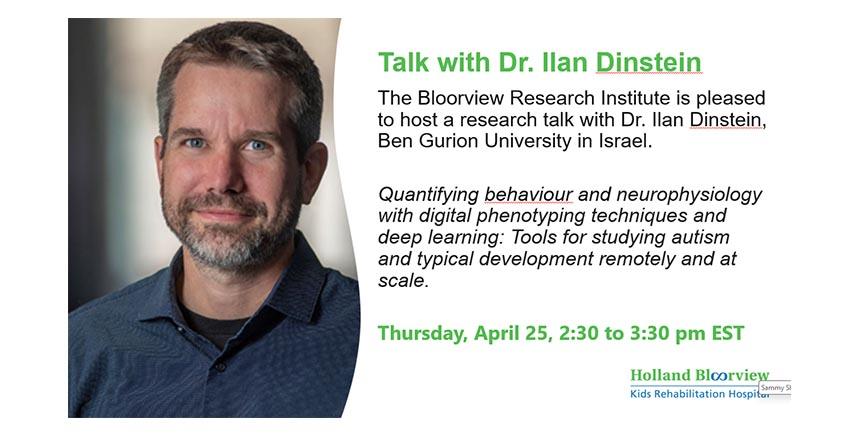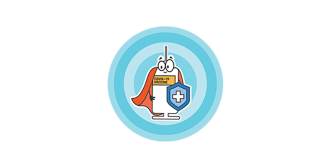Presentation: Quantifying behavior and neurophysiology with digital phenotyping techniques and deep learning: Tools for studying autism and typical development remotely and at scale

The Bloorview Research Institute is pleased to host a presentation with Dr. Ilan Dinstein, professor of psychology and cognitive & brain sciences at Ben Gurion University in Israel and deputy director, Azrieli National Centre for Autism and Neurodevelopment Research, Israel.
Registration is not required.
Zoom link to join if you are not able to attend in-person:
Join through this link.
Presentation: Quantifying behavior and neurophysiology with digital phenotyping techniques and deep learning: Tools for studying autism and typical development remotely and at scale
In modern society, we are immersed in technologies that are continuously measuring many aspects of our behavior and physiology using computer vision, speech analysis, eye tracking, and data from wearable or nearable devices. By applying deep learning algorithms to analyze these data, it is possible to identify and quantify specific behaviors that are indicative of a person’s social, cognitive, and motor abilities as well as their mental and physical health. Measuring such behaviors directly and objectively over extended periods of time in the home environment can reveal important insights about their stability within an individual and change over time, reducing reliance on subjective questionnaires.
Dr. Dinstein will demonstrate how digital phenotyping techniques can be used to study social abilities, motor stereotypes, and sleep in large-scale studies with typically developing children and those diagnosed with autism. Examples will include:
- Eye tracking to quantify social attention from gaze patterns of children watching naturalistic movies.
- Computer vision for quantifying facial expressions and repetitive stereotypical movements during behavioral assessments in a clinical setting.
- Speech analysis for quantifying social communication abilities.
- Wearable devices including EEG headband and smartwatch for quantifying sleep disturbances, sleep neurophysiology, physical activity and daily behavioral patterns.
These examples will demonstrate how digital phenotyping techniques are creating new opportunities for carrying out basic and clinical research remotely, at home or in a clinic, while removing barriers for participation by those who cannot come to a university or hospital setting. Dr. Dinstein will highlight techniques for studying social, motor, and cognitive development, measures that may serve as outcome measures for clinical trials in autism, and techniques that may accompany large-scale genetic studies.
Biography
Dr. Ilan Dinstein is a professor of psychology and cognitive & brain sciences at Ben Gurion University in Israel. He received his PhD from the Center for Neural Science at New York University in 2010, then completed his post-doctoral training in the neurobiology department at the Weizmann Institute and the psychology Department at Carnegie Mellon University.
Early research in Dr. Dinstein’s lab examined the stability of neural responses to sensory stimuli in humans using neuroimaging techniques. These studies demonstrated that individuals with larger trial-by-trial variability exhibited poorer perceptual abilities and lower motor accuracy. In parallel, he developed a broad research program into the neurophysiology and behavioral characteristics of autism with a particular focus on characterizing autism heterogeneity and longitudinal changes during early development. Dr. Dinstein developed collaborations with clinicians, researchers, parent groups, and self-advocates throughout Israel and established the Azrieli National Centre for Autism and Neurodevelopment Research in Israel. The center manages a national database and biobank for autism research with data from over 3,500 families.
Dr. Dinstein's current research focuses on developing digital phenotyping techniques and deep learning algorithms for studying social, cognitive, sensory and motor function in children with typical development and those with autism. This research utilizes eye tracking, computer vision, speech analysis, and wearable devices to quantify specific behaviors of interest remotely in large-scale studies. Ilan is also studying sleep disturbances and sleep neurophysiology using EEG headbands in the same participants to identify the interaction between sleep disturbances and severity of developmental problems. While this research has broad applicability, an important focus is to identify specific etiologies of autism, develop new techniques for early diagnosis, and establish direct and objective clinical outcome measures for specific symptoms (e.g., sleep disturbances).
